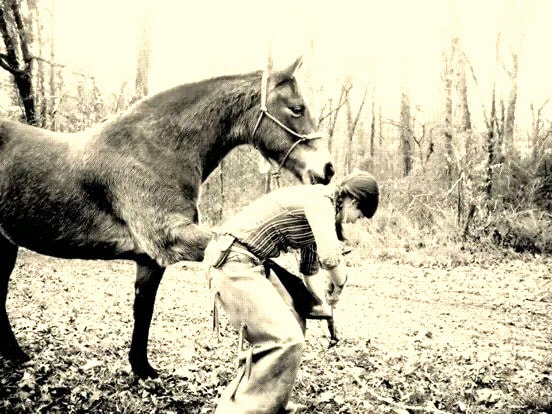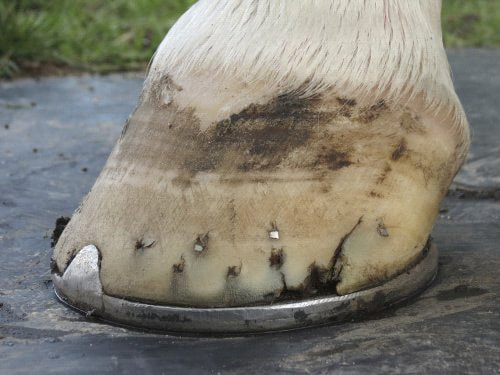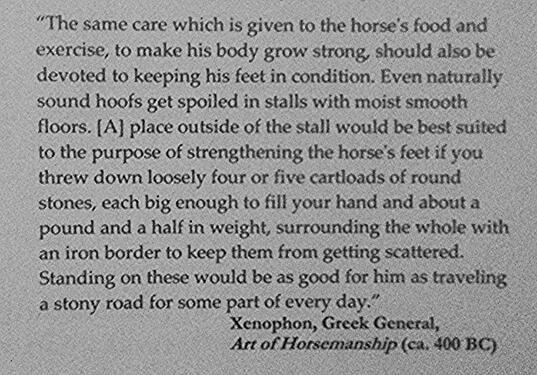|
Horses do not speak our language, but the goal as an equestrian is to learn to speak theirs. Everyone who has had the opportunity to bond with a horse knows that they are loving creatures with distinct personalities. As a farrier, I am blessed to be a part of your life and get to know your story. My job is to set forth a plan of correction and long term life goals for each animal.
Natural Hoof Care is about more than just a trim method. It involves the whole horse, with the feet as the foundation that allows the animal to perform his best. The Whole Horse Approach… It is not just about the trim, but rather taking into account everything about the horse in order to have the most success with your horse as a high performance barefoot athlete. This means environment, movement, diet and the trim. I think that one of the greatest misconceptions about horses with their hooves left in their natural bare state is the thought that the hooves need protection. That is because we have become accustomed to seeing diseased and weak hooves, with underrun heels, toe cracks, and a myriad of other issues.. The saying “No hoof, no horse” is still just as true today as it was hundreds of years ago. A horse that is being managed correctly will have a sound foot that can travel across whatever you throw at it. By balancing the horse’s hoof back to the internal structures, we are bringing the whole horse back into balance with his body. It is a holistic approach to hoof care which takes into account the living conditions and the terrain that the horse encounters on a regular basis. The trim is a tool that encourages the hoof to grow in a physiologically correct shape and the correct living conditions aid remodeling where necessary and help maintain a healthy hoof. When making the change to barefoot, the horse may be uncomfortable and sore at first, give him time to adjust. His feet will need time to toughen up again and develop strength. Horseshoes do not really provide much protection to the feet… After all what does a one inch band of steel around the perimeter of the foot do to protect the frog and the sole? Why not allow the horse to be in his natural state except when the protection is needed with the use of hoof boots? Easyboot, Renegade, ScootBoots, all are good options that give a horse protection when they need it, with all the benefits of being barefoot. Benefits to keeping your horse barefoot:
0 Comments
Proper Natural Hoof Trimming aims to:
For centuries now, we have been nailing steel horseshoes onto the bottom of a horse’s hoof for protection, but is a crescent shaped piece of metal really the answer? Luca Bein, in his 1983 dissertation in Zurich, measured the shock absorption of barefoot, shod, and alternately shod horses. He concluded that a conventionally shod horse shows an absence of 60-80% of the hoof’s natural shock absorption. He demonstrated that "a shod foot on asphalt at a walk receives THREE TIMES the impact force as an unshod horse on asphalt at the trot." Bein also found that a shoe vibrates at about 800 hz, which is high enough to cause damage to living tissue. Dr. Tomas Teskey, DVM. "Every horse that wears steel shoes suffers some degree of laminar separation. There are a myriad of other malfunctions that also occur in a shod hoof, and they all contribute to the hoof functioning in a completely different and abnormal fashion and it leads to a severe contraction in their size, so much so that when the shoe is removed the horses can no longer walk comfortably on their own feet. For the presence of steel on a horse’s feet, we are able to observe profound damages that occur due to the stagnation of blood within the hoof and the diminished return of blood back up toward the heart through the veins of the lower leg. Metal shoes interfere with the hoof’s natural blood-pumping mechanism. Period. I will never ask any client of mine to consider shoeing their horse with steel. I have conviction in my belief about this and it is unwavering. I feel that farriers and veterinarians and trainers and horse people must learn the truth about this and tell their clients, friends and colleagues that shoeing horses damages them and robs them of years of their lives." Dr. Robert Cook, FRCVS, PhD, Professor of Surgery Emeritus at Tufts University. "All horses" hooves are healthier without shoes, and barefoot horses are healthier than shod horses. They live longer, happier, less painful lives. Barefoot is a requirement for health and should be accepted as a condition for keeping a horse. Humane management is not just preferable, it is nonnegotiable. The foot evolved to function unshod. Nature has developed the perfect design for grip and slide in all conditions and provided for unsurpassable shock absorption. The foot cannot expand and contract with each step when clamped. Blood supply to the foot is impoverished, and horn production becomes deficient. When the foot is prevented from functioning correctly, the pastern, fetlock, cannon, and knee are also placed at risk. This leads to bone, joint, and soft tissue injuries." It has long been acknowledged that horseshoes cause long term damage to the internal structures of a horse’s leg and hoof... Isn’t it time that we made a change? In the world we live in today, shouldn’t our horses have better options than having a steel shoe nailed into his foot? If you were to present to any modern engineer the task of protecting a flexible, shock absorbing structure from abrasive roads and rough terrain, would a hard, rigid, concussive material like metal be the answer? Of course not, there has been a lot of advancement in the development of new materials over the past fifty years or so. We now have flexible, durable materials such as those in tires and high performance athletic shoes. Hoof boots allow the hoof to flex, expanding upon impact with the ground. You can fit most with sole pads to give additional support and stimulation to the sole and frog. Hoof boots can be an invaluable tool to be able to keep riding your horse while growing and developing a healthy bare hoof. In the past, you either got your horse's shod or left them without protection. Modern hoof boots have changed this, now allowing more horses to benefit from natural hoof care while having the best possible protection for their hooves. David Jones has also created a product that has been gaining more popularity and attention for its application. Hoof Armor is a tough, flexible, adhesive coating that goes on the horse's sole to help seal moisture and protect the sole from wear. It is abrasive resistant with properties of Kevlar, used in bulletproof vests. Its antimicrobial and antibacterial properties have been proven to cure White Line Disease, Thrush, and even toenail canker on an elephant!
Hoof Armor is being used on top endurance horses, barrel racers, eventers and trail riders. You can visit the website for more information about Hoof Armor at www.hoofarmor.co |
AuthorMisty Whitehouse ArchivesCategories |
HoursContact for appointment
|
Telephone270-505-6364
|
|





 RSS Feed
RSS Feed